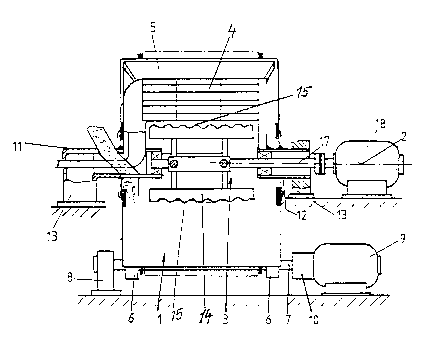Note: Descriptions are shown in the official language in which they were submitted.
GEORG FISC~ER AG - 8201 Schaffhausen
2688/GGG - 9 November 1990 - Li/we
Device for the batch-wise preparation of loose material
The invention relates to a device for the batch-wise
preparation of loose material, as described in the
preamble of claim 1.
A device of this type is known from DE-C2-29 09 408 in
which the impact rotor has beating blades with a
straight outer peripheral side. Beating blades of this
type are of simple construction but their abrasive
effect and hence also the regeneration effect of old
sand is unsatisfactory.
It is the aim of the present invention to produce a
device of the above-mentioned type whose impact rotor
is constructed so that it has the best possible
abrasive effect with a low power consumption for the
rotor drive.
According to the invention this aim is achieved by the
characterising features of claim 1.
Particularly advantageous embodiments of the invention
are characterised in the dependent claims.
Through calculations and experiments it could be
determined that in the case of a wave-shaped outer
peripheral side of the beating blades on the impact
rotor a substantially better abrasive effect is
achieved with the loose material to be prepared, and
also the power consumption for the impact rotor is
reduced. These wave-shaped beating blades cause a
2 ~
constantly alternating compression and relaxation of
the filling density between the drum wall and the rotor
circumference, and a great increase in turbulences in
the loose material is achieved and because the
particles are centrifuged against each other with more
force there is a better abrasive effect.
In addition there was a more uniform and, at the same
time, smaller amount of wear on the abrasive blades so
that their service life was extended.
The invention is represented and described below by
means of the enclosed drawings. These show:
5 Fig. 1 a longitudinal section of the device along the
drum axis and
Fig. 2 an enlarged partial plan view of a beating
blade of the impact rotor.
The illustrated batch-type device for the treatment of
loose material, in particular foundry sands,
essentially comprises a drum 1 rotating about a
horizontal axis 2, an impact rotor 3, a suction device
4 and a stripper 5 arranged thereon. The drum 1 rests
on drive rollers 6 and their shafts 7 are guided in
bearing blocks 8. One of the shafts 7 is driven by a
motor 9 via a reduction gear 10. Coaxially to the drum
axis 2 two fixed, tubular holding elements 11, 12 are
arranged in pedestals 13 on both sides of the drum 1.
In the two holding elements 11, 12 a shaft 17 is
mounted which is driven at relatively high speed by a
motor 18 and carries the impact rotor 3 inside the
drum 2.
?JQ3~9
-5-
The impact rotor 3 has at least two, preferably four,
beating blades 14 whose outer peripheral side 15 is
wave-shaped.
Advantageously the wave-shaped peripheral side 15
according to Fig. 2 i5 formed from respectively
alternating concave and convexly arranged quarter arcs
16 which have the same radii R. The peripheral side 15
can also be constructed in the shape of a sine curve.
1 0
The beating blade 14 can be made from a cast iron
material in a casting process or from a steel plate by
a material-removing or cutting process. Wear-resistant
materials, such as e.g. chilled cast iron, alloyed cast
steel or alloyed steel or even a wear-resistant
spheroidal graphite cast, are preferably used for this.
There is also the possibility of making wear-resistant
at least those parts of the beating blade exposed to
great wear, by coating or welding a wear-resistant
material such as e.g. hard steel, sintered material,
ceramics, oxide ceramics etc.
The wear layers or parts can also be produced by
adhesion, sintering or compound casting.
The beating blades 14 are preferably connected to the
impact rotor 3 in an easily exchangeable manner, e.g.
by means of screws or a clamp connection.
